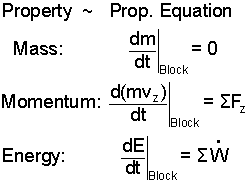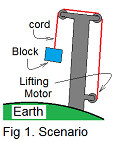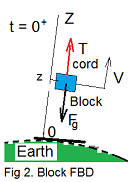| THERMO Spoken Here! ~ J. Pohl © | TOC NEXT ~ 180 |
Gravity Work-Rate:
This is simply a discussion of terms, ideas and if what we think we know we know. A student having given some thought to a quite simple event of a Block, used definitions from physics along with Newton's 2nd Law. The student arrived at a contradiction. At the very lowest level... a contradiction? Fortunate for us (or maybe not), the student wrote down the diellema. No answer will follow this. The answer depends upon how you see it.
A physics student imagined an event of a Block. She modeled the Block as a BODY then analyzed the physical situation in two manners and obtained results that seemed contradictory. The student's wrtten statement is below. Beneath that a discussion: What was said and what does it mean.
======
Student statement: Suppose a block is being raised at constant velocity by a tension in a cord against the force of gravity. Is there any work done on the block?
My first answer was "no," since Work = Force*Distance, Force = Mass*Acceleration, and if velocity is constant then acceleration is zero and force equals zero. So then work is zero.
However work also comprises mgΔH, and if the height is changing then there is an increase in potential energy. So my second answer is yes there is work. Please resolve this contradiction.
======
First let's try to agree on our assumptions of what the student's statement means. I suggest the following:
Scenario: The physical scenario, the reality in mind, the matter in consideration, is the Block as it experiences its event. The Block, a model of physical reality, is being raised by a force acting through action of "tension through an attached cord" while the "force of gravity" acts oppositely on the Block, in opposition to the raising event. Nonetheless, the Block moves upward at constant velocity.
System: The defined system is the Block (only). Earth as acknowledged contributes to the event by way of its mass (at a distance), via its "gravity force." From this perspective Earth and the Block do not form a "potential energy" pair.
Question: "Is there any work done on the Block?" This request is specific. There is "work," there is "work-net," "work done on" and "work done by..." The request is "work done on."
If agreed that the above is what the discussion is about, below we discuss perspectives.
The student analyses the system from two vantages (1) and (2)
- - - - - -
Student Analysis 1: "... since the following equations apply as shown...
 ... one concludes "work" is zero.
... one concludes "work" is zero.
==========
Author 1: This argument by intersplice of definitions concludes "The work of a Block that moves at constant velocity equals zero" appears sound but how is it relevant to the question asked?
(i) "Force equals mass times acceleration" is true in a dimensional sense. That is [F] = [m][L][t]-2. If "work equals zero" is then "work done on equal zero," or what?
This argument is imprecise. Does it address the Block? For the Block: F ≠ mA but ΣF = mA. ==========
Student 2: "... but work comprises mgoΔH,... if height is changing... conclude "work done on" is NOT zero.
==========
Author 2: "work" does not "comprises mgoΔH." Work and To indtoduce potential energy (being an Earth-and-Block as system idea) is to return to change the system from Block (only) to be Earth and Block (combined as system). What has change of potential energy to do with "work done on?" Please show effort, show steps of your logic.
Also The interest is "work done on." To head this way, please show what "work done on" has to do with is, and how the "work" as
in the above equations being zero parses to conclude "work done on" is zero.
==========
Author's Comments: The student is clear in asking for "work done on."
Explanation:
The student's statement is unclear. Work is not germane for this "steady-continuing" event. "Work-rate" is the proper work-related form. Work (and work-rate) as ideas arrived to engineering physics about the time Watt and Newcomen developed the first steam engines. The student does not define the system for either analysis. What system, the reader must deduce.
Conclusion 1: The student is correct. The work-rate of the Block is zero as a sum of two equal and opposite work-rates in action.
Conclusion 2. The student, by mention of potential energy, is using "Block and Earth" as the system. A work-rate occurs, it is the tension of the cord times its vertical velocity. This work-rate equals the rate of increase of potential energy of the Earth/Body system.
Solution 1: For the first analysis, the student uses the Block as system. Also he makes the classic algebra-based-physics mistake. His use of "F" in Newton's 2nd Law causes him to overlook a force. One should use ΣF in the 2nd Law, as Newton intended.
So our task: Block as system, multiply Newton's 2nd Law by Block velocity. Obtain relation for work-rate.
| Newton's 2nd Law addresses momentum of the Block in our "0Z" coordinate system. Best ALWAYS to use ΣF. |

| (1) |
| Mass of the Block and its vertical velocity are constant so left-of-equality equals zero. |

| (2) |
| Expand ΣF to establish gravity force as equal and opposite to the cord force. This is obvious but needed later. |

| (3) |
| Return to Eqn-2, multiply the equation by the vertical velocity of the Block. |

| (4) |
| Now expand the sum of forces. |

| (5) |
| Write the forces as magnitudes and directions. |

| (6) |
| The vector multiplications determine the signs: |

| (7) |
| Force times velocity equals work-rate. The sum of these work-rates is zero. |

| (8) |
Conclusion 1: The student is correct. The work-rate of the Block is zero as a sum of two equal and opposite work-rates in action.
######################
Solution 2. The student's statement "work equals mgoH" is not applicable from the aspect work. Work-rate as "work-rate = d(mgoH)/dt" is relevant. The mention of increasing potential energy reveals the system to be the Block and Earth taken together. This development below addresses the Block initially with Earth participating via gravity force. Block and Earth are brought together near the end.
| Newton's 2nd Law addresses momentum of the Block in our "0Z" coordinate system. Best ALWAYS to use ΣF. |

| (9) |
| In this and a great many instances, gravity force is relevant. Remove the force of gravity from the sum of forces. |

| (10) |
| As before, multiply Eqn-9 by the velocity of the Block. Three terms are obtained. |

| (11) |
| By basic definitions of calculus, the term left-of-equality Eqn-11 is altered as follows: |

| (12) |
| Right-of-equality, the first term changes as follows: |

| (13) |
Since zo is a constant, dzo/dt = 0. The term is "(z - zo)" as a convenience. Place the results, Eqn-12 and Eqn-13 into Eqn-11. Thus with a little grass-roots calculus, Newton's 2nd Law multiplied by velocity, can be represented as Eqn-14.
Important: Although Newton's 2nd Law has been transformed, the system it addressed initially has not changed. That system is the Block. The terms of Eqn-14, left to right are: A modification of momentum, the work-rate of the gravity force and the work-rate of all other forces. This form, known to many persons in the years after Newton's death, displays a new idea, energy of a BODY.

| (14) |
A Body has characteristics (position and velocity) and properties (mass, momentum for now - energy soon). Supposing the mass of a Body is known, for any event its position and velocity can be made quantitative, is observable, and measurable from an external non-intefering reference (called extrinsic, by some). The terms of Eqn-14 are specified simply in terms of velocity and elevation relative to Earth.

| (15) |
When we move the gravity work-rate term from right-of-equality to left-of-equality, the effect is change our system from "Block" to "Block and Earth."

| (16) |
As a last step we define kinetic energy as KE, and potential energy as PE. Substitute these definitions into Eqn-17.

| (17) |
We can group the terms within the differentiation.

| (18) |
The above concludes the development.
Conclusion 2. The student, by mention of potential energy, is using "Block and Earth" as the system. Consequently Eqn-16 applies. Since the vertical speed is constant, the first term is zero - Eqn-19. A work-rate occurs, it is the tension of the cord times its vertical velocity. This work-rate equals the rate of increase of potential energy of the Earth/Body system.

| (19) |
##################################################################
##################################################################
##################################################################
##################################################################
Other comments below!


S-1: describes a scenario: ... a block moves upward at constant speed by pull of a cord. Gravity force opposes the motion. We assume some manner structure with a "lifting motor" to power the event. Analysis generally begins from the vantage of a physical secnario approximated by a sketch - The scenario - Figure 1.
By Newton's method, the next task is to select (from the scenario) a system (that matter to be analyzed) then represent it as a Free-Body-Diagram (FBD). An obvious system is the Block. To draw a FBD requires experience. The completed FBD is Figure 2.
 To draw a FBD requires a number of decisions. The FBD is a sketch of the system once it is isolated from the remaining matter of the scenario. Newton's idea was to "isolated" the matter otf the system from all else - the all else he called, the surroundings. That is a first step. So though the system was isolated, its events were still subject to influence of the surroundings. The complexity of these ideas, physical truths and their approximations are depicted graphically (and by notations) on the FBD.
To draw a FBD requires a number of decisions. The FBD is a sketch of the system once it is isolated from the remaining matter of the scenario. Newton's idea was to "isolated" the matter otf the system from all else - the all else he called, the surroundings. That is a first step. So though the system was isolated, its events were still subject to influence of the surroundings. The complexity of these ideas, physical truths and their approximations are depicted graphically (and by notations) on the FBD.
- Model: Physical reality is always studied approximated as a model. The Block is modeled as a Body.
- Coordinates-Basis/Characteristics: Position, and velocity are system characteristics. A coordinate reference 0Z with origin and unit vector: K is notated.
- Properties/Property Equations: Our Block has three properties: one property, its mass which is constant.
- Event: The abstract event is the relation of time to physics is No event, permanance, batch and continuing are common choices. Event is the abstract of time.. as it continues. Physically real
Body and Boundary Forces: Since the system is imagined a part apart from reality, forces are applied to approximated. - ... and others not needed here.
Question 1: Is there work? Strictly speaking, No. Work is associated with a start/stop or commence/end type of event. Events for which a force is displaced an increment without regard for the time required. Our event the time-wise nature "continuing." For our event (continuing) "work rate" is germane.
Newton's 2nd Law has no work-related term. However, were the 2nd Law multiplied by the vector velocity, two work-rate terms appear. The case we study is very special. Since vertical speed is constant, left-of-equality is zero, which greatly reduces this discussion. , we avoid

The terms right-of-equanity in the 2nd Law (multiplied by velocity are work-rate terms. Work is energy or momentum change of a system. Work-rate is energy rate of change or momentum rate of change. to or from a system. The tension of the cord times its vertival velocity
from surroundings, needs a manner to recognize that "surroundings being there" might influence the event. System selection, isolation, selection of forces with notation and a new sketch... these steps yield a free-body-diagram.
Terms and Ideas:
Simply a discussion of terms, ideas and if what we think we know we know. A student having given some thought to a quite simple event of a Block, used definitions from physics along with Newton's 2nd Law. The student arrived at a contradiction. At the very lowest level... a contradiction? Fortunate for us (or maybe not), the student wrote down the dillema. No answer will follow. The answer depends upon how you see it.
Premise presently unwritted!